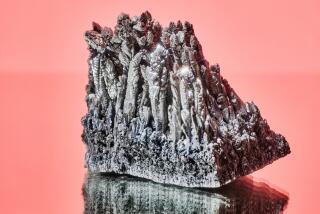Scientists shed light on how resveratrol works
Scientists hoping to mimic the life-extending qualities produced by a chemical found in red wine and dark chocolate say they have solved one of the mysteries about how this compound works to combat the effects of obesity, diabetes, certain cancers and a host of other maladies.
The findings, published in Friday’s edition of the journal Science, could lay the foundation for a variety of drugs that act like concentrated amounts of resveratrol, the compound that has inspired a $30-million-a-year supplement business. Pharmaceutical giants have invested millions of dollars in the quest to improve on the compound that helps rev up the body’s cellular defenses against disease and aging.
Harvard geneticist David Sinclair and his colleagues have been working for more than a decade to uncover a chemical link between resveratrol and a group of enzymes known as sirtuins, which can trigger proteins that rejuvenate cells. The new results will help achieve a “more rational design” of resveratrol-related drugs, Sinclair said.
“We were working in the dark before,” he said.
Sinclair’s resveratrol-related research has vaulted him to rock-star status by the standards of biochemists. He has sipped wine on “Nightline” and “60 Minutes” and presented his work at industry conferences. In 2008, GlaxoSmithKline paid $720 million for Sirtris, the biotech firm he cofounded to commercialize his discoveries. He remains on the company’s scientific advisory board.
But Sinclair’s results touched off an academic imbroglio, some of it fueled by rival pharmaceutical companies.
Scientists on both sides reacted with enthusiasm to the latest resveratrol findings, saying they would lay to rest a key disagreement, even if they won’t dispel skepticism about the possibility for a pharmaceutical fountain of youth.
“We’ve known that it’s true in the test tube,” said Matt Kaeberlein, a University of Washington biogerontologist who has questioned some of Sinclair’s studies. “What this does is suggest the same thing is true in cells.”
“This is not weak evidence at this point,” said Leonard Guarente, a biologist at the Massachusetts Institute of Technology who trained Sinclair and several of his critics. “You would really bet the ranch on this one.” Guarente also serves on the Sirtris scientific advisory board.
The latest advance by Sinclair’s team isn’t likely to have the mass appeal of earlier studies that showed resveratrol could improve heart function in people, make obese mice as nimble as thin ones and cause flies, fish and worms to live longer. Those splashy results fueled the rise of high-dose resveratrol supplements, which have not been vetted in clinical trials the way drugs are. Interest in the compound has also boosted sales of red wine, though scientists have cautioned that oenophiles would have to drink about 100 bottles of wine each day to get anywhere near a workable dose of resveratrol.
But the new work in effect put to rest contentions that earlier laboratory results were unlikely to occur in nature.
Detractors had claimed Sinclair’s data were influenced by a fluorescent chemical — one that doesn’t occur in nature — that he used to measure the activation of sirtuin proteins by resveratrol-like compounds. For the new study, Sinclair and his colleagues essentially repeated the experiment with naturally occurring amino acids instead. The reaction worked.
A major branch of anti-aging research centers on the effects of calorie restriction, which can send cells into a crisis mode that prompts them to repair damage and stave off hazardous changes in cellular activity. Resveratrol, found in such foods as grapes, peanuts, cocoa and berries, provokes similar reactions.
How resveratrol and similar compounds worked remained something of a mystery. Scientists believe it stimulates a sirtuin known as SIRT1 that breaks up certain proteins, helping them change cell behavior in ways that are beneficial to health.
“SIRT1 is like a Pac-Man that removes these proteins and tells other proteins to go out and repair the cell,” Sinclair said.
When SIRT1 was active, miraculous things seemed to happen. Was it too good to be true?
GlaxoSmithKline didn’t think so. But scientists, including some paid by rival pharmaceutical giant Pfizer Inc. and others without direct economic interests, began to squabble over the molecular path to the fountain of youth. The disagreement split researchers who shared academic roots at Guarente’s MIT laboratory.
The Science paper, so far, appears to have accomplished a detente, although several researchers, including Sinclair, said there was still a way to go before any miracle pill appears on the market, if it ever does.
“It might bring together the different views so we can move forward,” said Brian Kennedy, president and chief executive of the Buck Institute for Research on Aging in Novato, Calif. Kennedy, also a protege of Guarente, has questioned some of the results involving resveratrol compounds and yeast. “This is how science works.”







